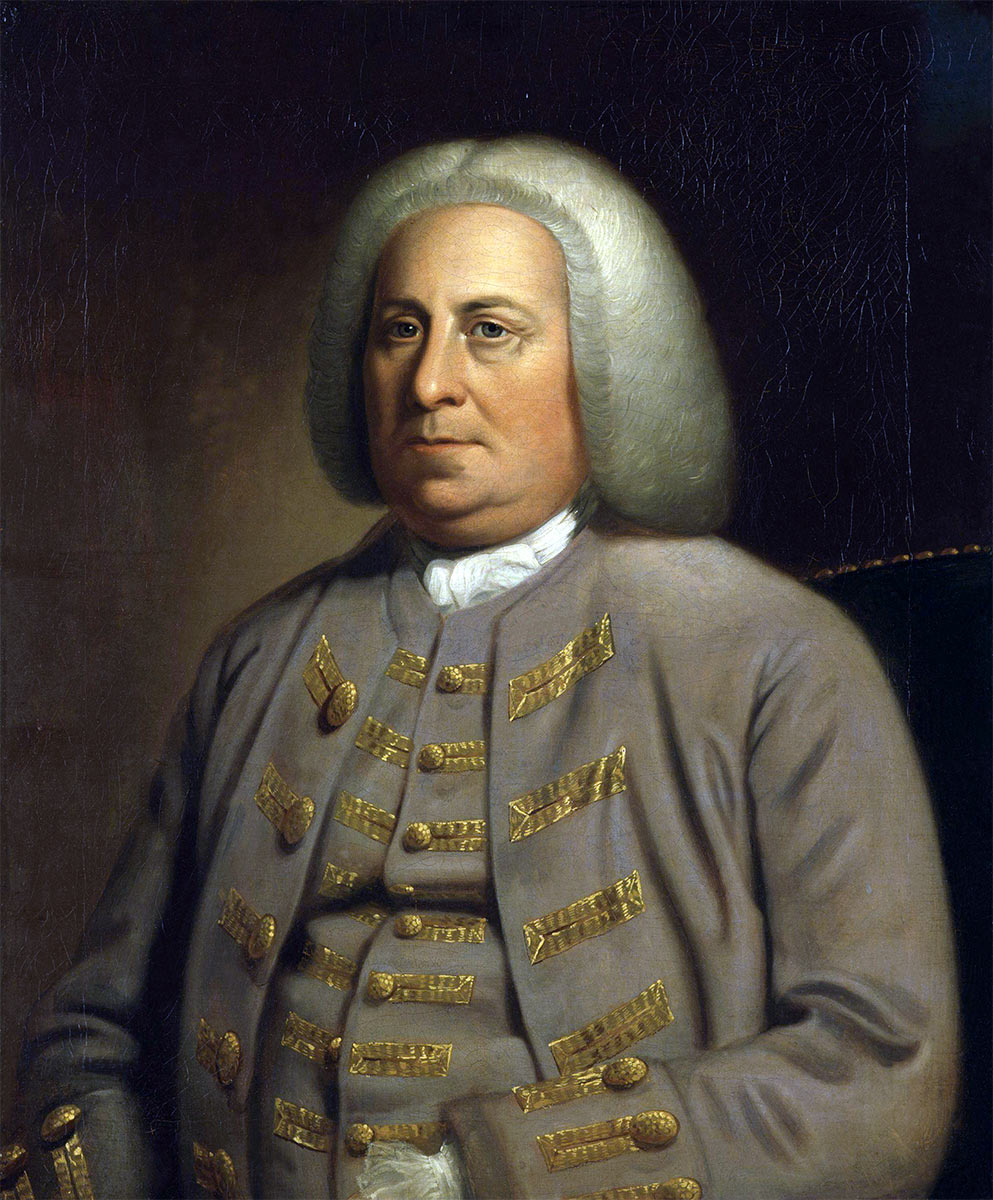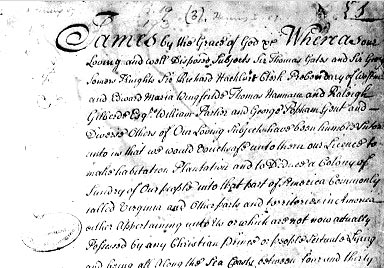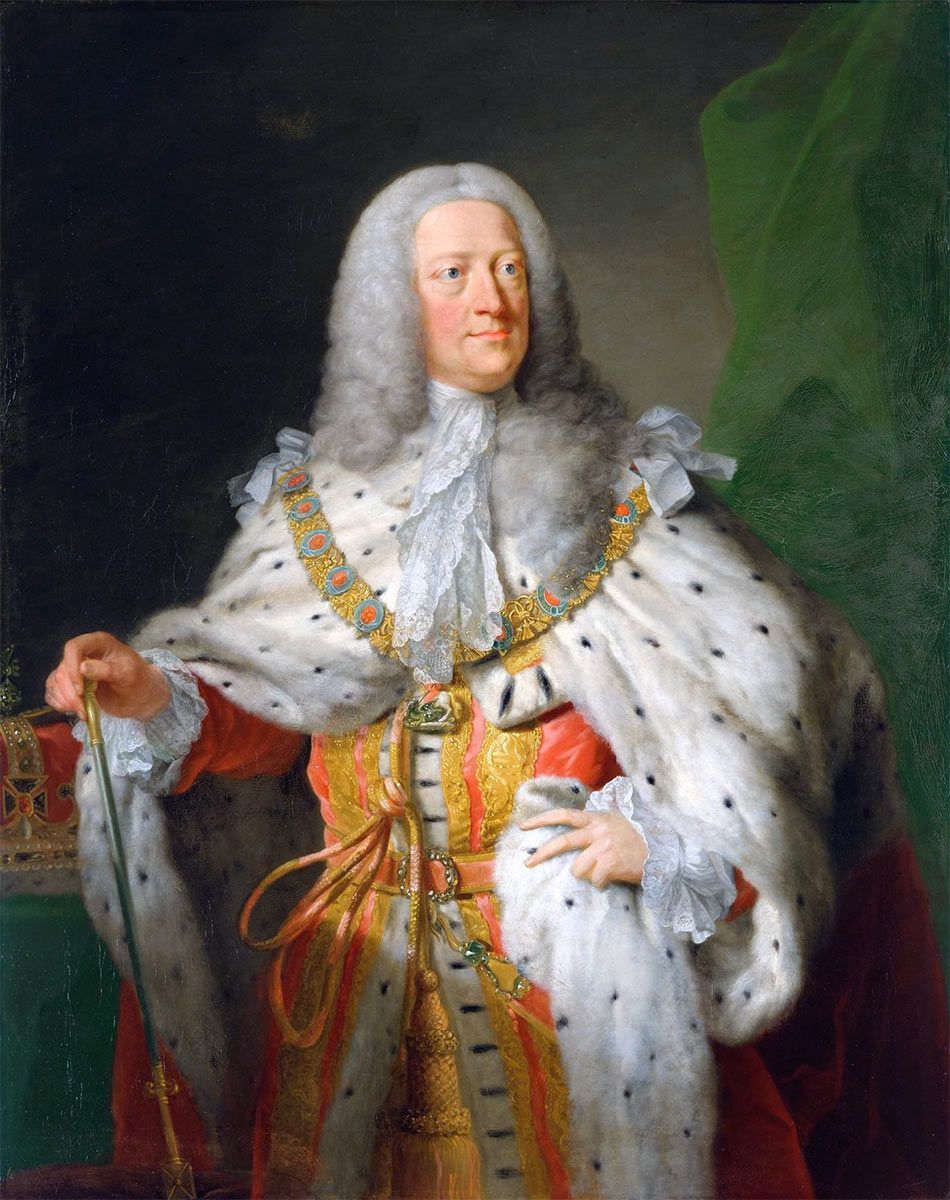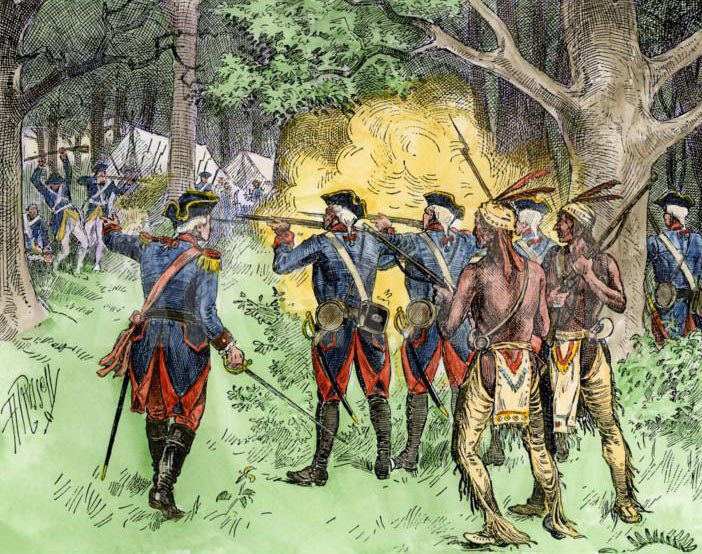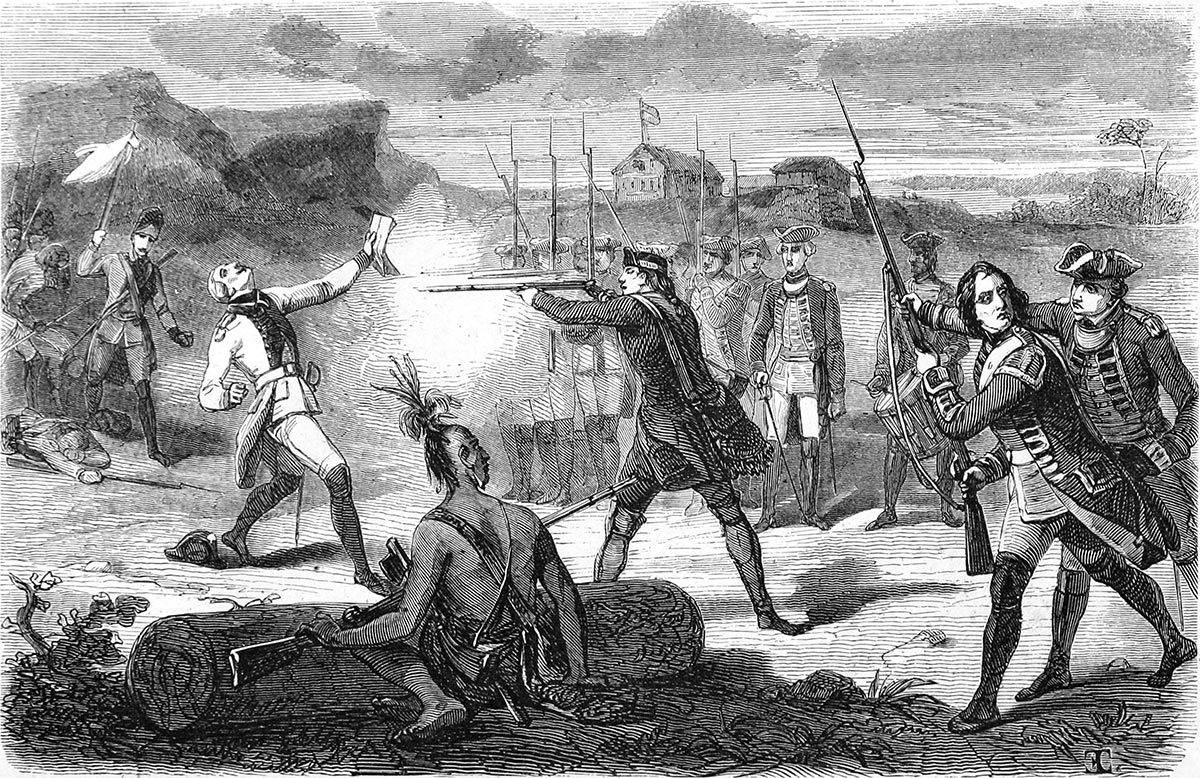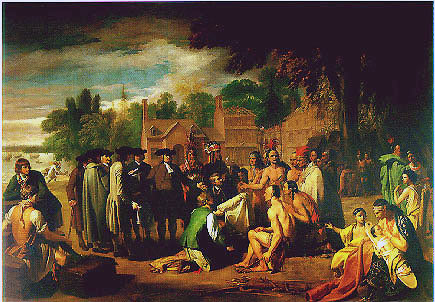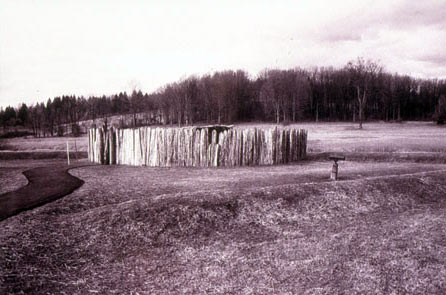The account of General Braddock’s expedition to Fort Duquesne in 1755:
Part 2: The deterioration in relations between Britain and France in America
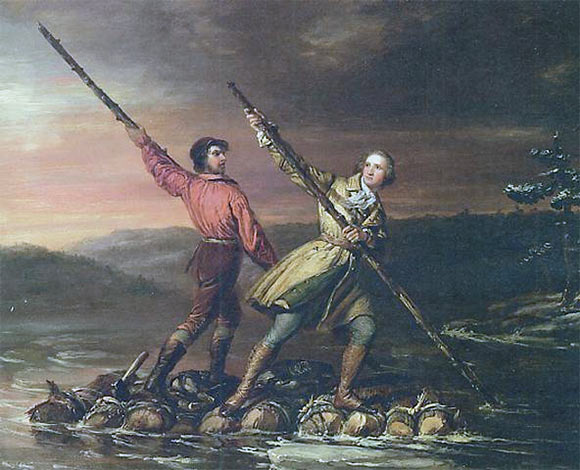
George Washington and Christopher Gist returning from their mission to Fort LeBoeuf on a raft down the Allegheny River in January 1754 (Gist at the back): picture by Daniel Huntington: Death of General Edward Braddock on the Monongahela River on 9th July 1755 in the French and Indian War
The previous section on Braddock’s defeat on the Monongahela in 1755 is Part 1: The origins of General Braddock’s expedition
The next section on Braddock’s defeat on the Monongahela in 1755 is Part 3: The Planning of General Braddock’s expedition
To the French and Indian War index
The appointment of Robert Dinwiddie as Lieutenant Governor of Virginia:
On 4th July 1751, the new Lieutenant Governor of Virginia was appointed, Robert Dinwiddie. Dinwiddie had served as collector of customs duty in the colony and was known and largely disliked from this service. Dinwiddie would play a major role in the action taken against French encroachment in the Ohio country and the launching of Braddock’s expedition.
Dinwiddie was also a member of the Ohio Company. With two successive lieutenant governors of Virginia and several influential Virginians and others as members of the Ohio Company, British policy in America would increasingly be influenced to serve the company’s interests.
The British North American colonies were an extraordinary muddle of conflicting interests. Each colony possessed an assembly elected from the most influential provincials and a governor representing the interests of the British Crown or the nominal owner of the colony based in Britain.
The history of British America in the 18th Century shows a succession of quarrels between these two institutions in most of the colonies. None of the colonies had a workable constitution, so that many major problems of administration remained insoluble. Even the physical limits of the colonies were uncertain, other than the small eastern seaboard colonies that had larger British neighbours hemming them in; Rhode Island, Connecticut and New Jersey. Arguments over boundaries even led to fighting between Maryland and Virginia.
Virginia was defined by the charter issued by King James I in 1606 as that part of America lying between the 35th and 40th Parallels. The Virginians, in order to support their claim to the Ohio Area, bent these lines to run west-north-west rather than directly west.
Pennsylvania was defined as an area 3˚ from the Atlantic coast. The dimensions of Pennsylvania could not be resolved until it was decided from where on the winding Atlantic coast-line the distance was to be measured.
British strategy in North America:
An overview of British interests in North America at the outbreak of the French and Indian War, also known as the Seven Years War, in 1755 shows that the main areas of concern over French incursion were the northern and western borders of New York and the northern borders of New Hampshire and Acadia or Nova Scotia.
When war was proposed by the British, Braddock’s force was sent to Virginia to attack the French at the Ohio Forks as the military priority, with action in the other three areas, Niagara, Crown Point and Fort Beausejour (all in the north) set as subsidiary.
An argument put forward for this course was that the Ohio remained ice free and, due to the early spring, military activity could begin earlier. The real cause was the pervasive influence of Virginia over British Government policy in North America. From 1751 to the outbreak of the war the main conduit for this influence was Robert Dinwiddie and one of his principal motivations will have been his financial interest in the Ohio Company.
The intention of the Ohio Company was that Braddock’s army drive the French from the Ohio Forks, where its valuable grant of land lay. In the course of its advance Braddock’s army would build the road the Ohio Company needed for access to that area from Virginia, along the route of Nemacolin’s path. A world war would be launched in an attempt to realise the interests of a group of Virginian property speculators.
Map of the eastern seaboard of the American colonies in 1755
Appointment of the Marquis DuQuesne as French Governor of Canada:
The slide towards war in America began with the arrival of the Marquis Duquesne as the new French governor of Canada, in 1752.
In early 1753, on Duquesne’s order, a strong French force landed on the eastern shore of Lake Erie and began to build a line of three forts stretching to the Allegheny River, a tributary of the Ohio River.
The effect on the Native Americans of this incursion in strength was dramatic. Many Native Americans, who were previously committed to the British, went over to the French. Duquesne’s instruction to the force commander was to build the final fort on the Allegheny River and then travel down the river to the Ohio Country. This third fort was not built. The French force was decimated by disease and rendered incapable of further action, until it finally withdrew to Canada.
Dinwiddie’s warning to the British Government in 1753:
Hearing of the French operation to build the line of forts, Dinwiddie wrote to the British Government alerting it to the threat from the French: a threat, Dinwiddie warned, to the very existence of the British colonies. The response to Dinwiddie was dated 28th August 1753 and was signed by King George II himself. It directed Dinwiddie: “If you shall find that any number of persons shall presume to erect any fort or forts within the limits of our province of Virginia, you are first to require of them peacably to depart; and if, notwithstanding your admonitions, they do still endeavour to carry out any such unlawful and unjustifiable designs, we do hereby strictly charge and command you to drive them off by force of arms.”
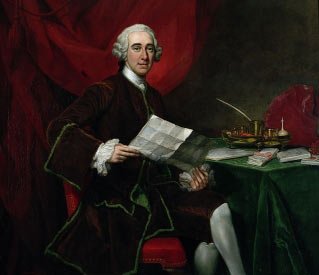
Robert Darcy, 4th Earl of Holderness, Secretary of State for the Southern Department until 1754: picture by George Knapton
It is clear that the King and his advisers had no real idea of just how far from Virginia the French were, in giving Dinwiddie this discretion to use force against them.
Lord Holderness’s instruction to the governors of the British North American Colonies:
On the same day, 28th August 1753, Lord Holderness wrote to all the provincial governors, instructing them “to repel any invasion which might be made ‘within the undoubted limits of His Majesty’s dominions.”
Of course the problem was, ‘What were the ‘undoubted limits of His Majesty’s dominions’? For those of the view of Lee and Dinwiddie this seemed to be most, if not all, of North America.
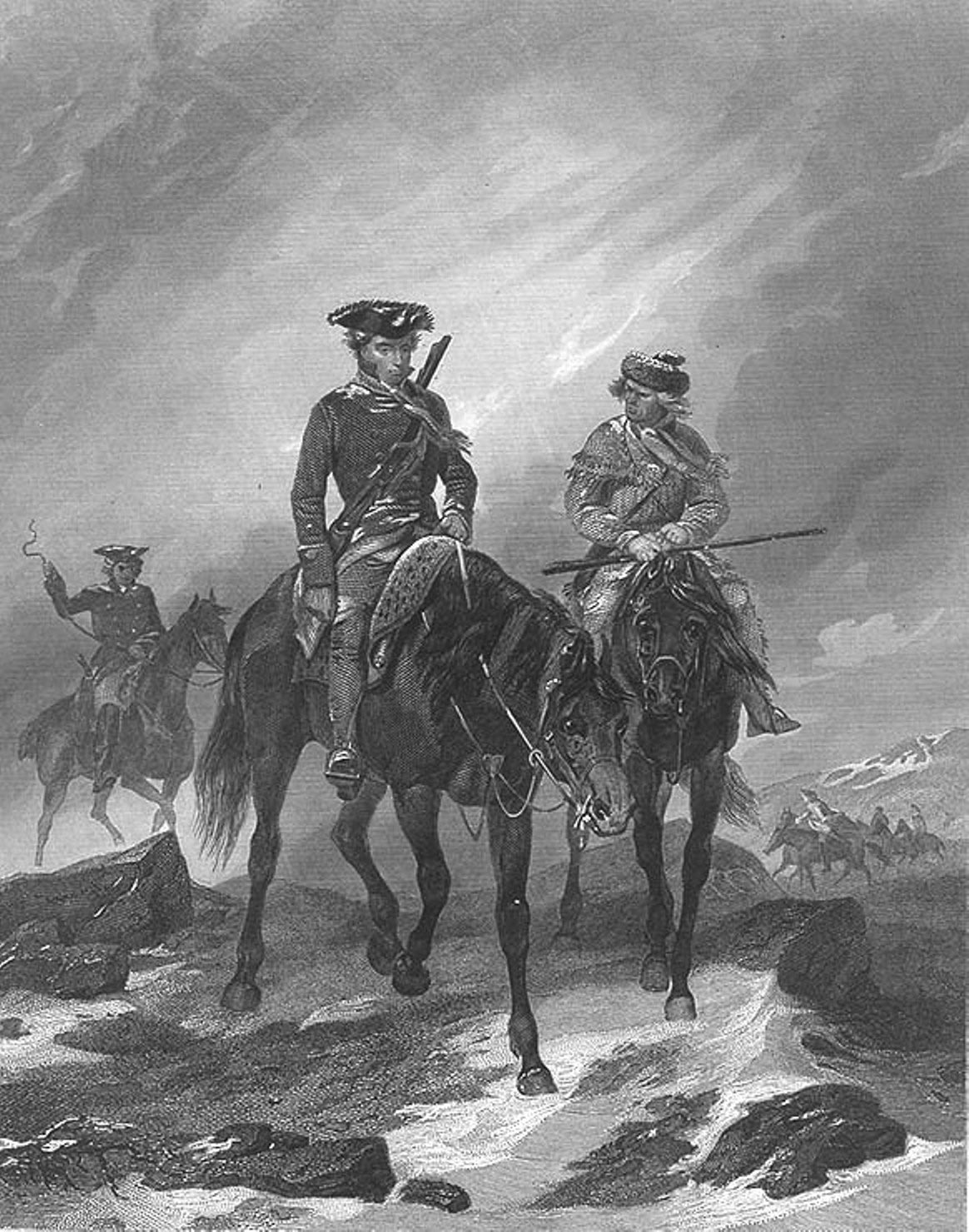
George Washington and Christopher Gist on their mission from Dinwiddie to the French at Fort le Boeuf in 1753
George Washington’s mission to the Le Boeuf River:
On receipt of these instructions, Governor Dinwiddie sent George Washington, on 11th December 1753, with a small party to deliver a letter to the French commander on the Allegheny River, informing him that he was trespassing on British territory and requiring him to withdraw to Canada. With considerable difficulty, Washington travelled to Fort LeBoeuf and passed his letter to the French commandant. Washington returned to Williamsburg, the provincial capital of Virginia, to report to Dinwiddie on 16th January 1754 that the French had no intention of complying with Dinwiddie’s demand.
Dinwiddie misleads the British Government:
The French intended to establish a dominance over the rivers making up the Ohio River system from the Allegheny to the Mississippi. While this policy would, in due course, impose a limit on the western expansion of the British colonies of Pennsylvania and Virginia, it did not pose a threat to the continued existence of these colonies, as Dinwiddie was warning the Home Government. Effective Virginian westward expansion had not yet reached the Potomac, which was more than one hundred miles of inhospitable mountainous and forested country short of the Ohio River forks.
It is interesting to note that after the French and Indian War the British authorities found it necessary to impose a policy of preventing Virginian colonists from settling west of the Alleghenies to conciliate the Native Americans in the area, similar to the action Dinwiddie found so threatening in the French.

‘His excellency Arthur Dobbs esq., captain general, governour in chief and vice admiral of the Provence of North Carolina in America’
The Ohio Company’s further application to the British Government:
The wording of the original grant of land at the Ohio Forks to the Ohio Company had been vague, giving the company the opportunity to take whatever land it found to be the most profitable. With increasing pressure for grants in the area, particularly from Pennsylvania, the Ohio Company decided to seek a further more specifically worded grant from the British Government.
On 2nd April 1754 a committee of the Ohio Company submitted to the Board of Trade in London a petition requesting an enlargement of the company’s grant with a detailed description of its boundaries.
The members of the Ohio Company committee were Arthur Dobbs, John Hanbury, Samuel Smith and James Wardrop.
Arthur Dobbs was appointed Governor of North Carolina on 25th January 1753, taking up his appointment in October 1754.
John Hanbury was agent to the Virginia Planters. Based in London, he was also de facto adviser to the British Government on America and was appointed contractor for General Braddock’s expedition, loaning the British Government £10,000 for the expedition.
Samuel Smith was a London merchant and member of the Ohio Company.
James Wardrop was a Marylander with land in Virginia and a member of the Ohio Company.
The petition from the Ohio Company was favourably received by the Board of Trade in London, but there was insufficient time to consider it before the launching of hostilities against France at the end of 1754.
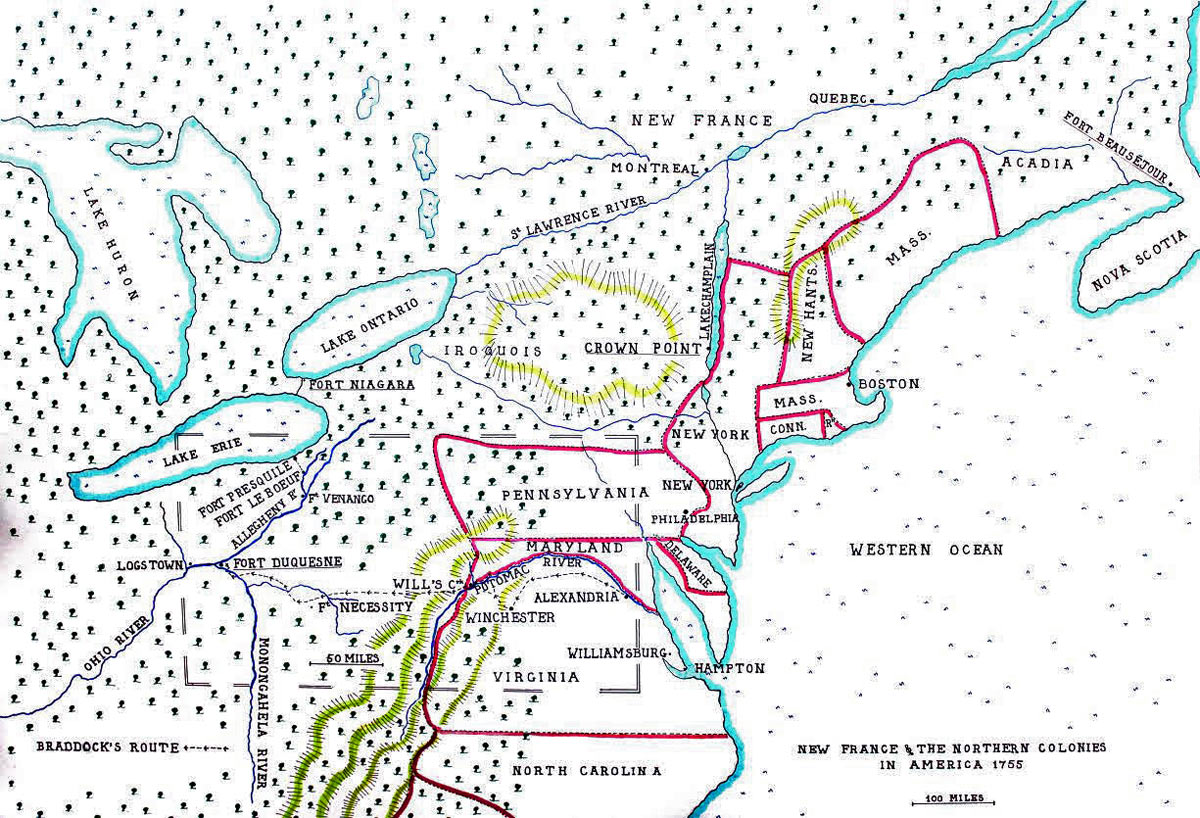
Map of the North American Colonies in 1755 showing the four intended targets for the British offensive operation: Fort Duquesne, Fort Niagara, Crown Point and Fort Beauséjour: map by John Fawkes: Death of General Edward Braddock on the Monongahela River on 9th July 1755 in the French and Indian War
Captain Trent’s mission to build a fort at the Ohio Forks:
With funds provided by the Virginia Assembly, Dinwiddie dispatched Captain Trent, in command of a force of one hundred men from the newly raised Virginia Regiment, to build a fort at the Ohio Forks, thereby forestalling the French. This Trent did.
William Trent was a Pennsylvania trader working for the Ohio Company.
A French expeditionary force, commanded by Contrecoeur, arrived at the Ohio Forks on 17th April 1754. He found the new fort occupied only by a party of some forty Virginians commanded by Ensign Ward, a young and junior officer.
Ward capitulated and left the fort to the French, who replaced the Virginian fort with a more ambitious structure, which the French named Fort Duquesne in honour of the Governor of Canada and which became the target for General Edward Braddock’s disastrous campaign in 1755.
The commander of the Virginia regiment, Colonel Joseph Fry, was on his way to the Ohio Forks with three hundred men to form the garrison of the new fort, when he fell from his horse and was killed. Command of the Virginia Regiment fell on the major, George Washington, who was at Will’s Creek. Washington was a member of the Ohio Company. Washington assembled the regiment for a counter-stroke to re-take the fort from Contrecoeur.
The reply of the Pennsylvania and New York Assemblies to their Governors’ requests for funds for defence:
In the meantime, the various colonial authorities were reacting to the alarm calls from the home government.

Governor James Delancey of New York
On 23rd April 1754, the New York Provincial Assembly answered Governor Delancey’s call for funds to finance a military response by saying “It appears that the French have built a fort at a place called French Creek (a reference to Fort le Boeuf on la Rivière aux Boeufs), at a considerable distance from the River Ohio, which may, but does not by any evidence or information appear to us to be an invasion of any of his Majesty’s colonies.”
Equally the Pennsylvania Assembly denied that the French presence at the Ohio Forks was on British soil.
While this was not a helpful response to the call for spending on ‘defence of the realm’, it was a realistic assessment of the French presence on the Allegheny River. If this had been replicated in the minds of the British Government and the Lieutenant Governor of Virginia, the French and Indian War might have been avoided or at least significantly delayed.
Dinwiddie’s correspondence with Governor Sharpe of Maryland:
Dinwiddie continued to conduct the affairs of Virginia as if there was a direct threat to the existence of that colony from the French. In a letter to Governor Sharpe of Maryland, Dinwiddie commented on the refusal of the Maryland Assembly to contribute funds to repel the French, saying “If they would look forward and consider the dismal consequences that must follow the settlement of the French so near our frontiers, they certainly would cheerfully assist with a proper supply. Besides, they ought to show themselves good subjects, as the Dignity of the Crown, His Majesty’s just right to these Lands, and the safety of the Colonies much depends on this expedition.”
Dinwiddie’s letter was a cynical play on the traditional fear of the French, with an additional suggestion of disloyalty to the British Crown.
Washington’s clash with the French officer Jumonville:
On 28th May 1754 George Washington marched the Virginia Regiment out from Will’s Creek, with the object of capturing the French fort at the Ohio Forks. A French officer, Jumonville, was killed in a clash between the Virginians and the French supported by a band of Native Americans. It seems likely that Jumonville’s death was inadvertent or that he was killed by one of the Native Americans accompanying Washington, but great play was made of the incident by the French authorities, who described it as an ‘assassination’.
The Albany Conference:
Between 19th June and 11th July 1754 the Governors of the Northern British Colonies held a conference at Albany, the capital of New York, in an attempt to improve their relations with the Native Americans and stop them defecting to the French. At the conference Benjamin Franklin put forward his plan for closer integration of the British colonies to improve their reaction to the outside threat. The plan was adopted by the conference, but effectively rejected by the state assemblies and by the British Government, which wanted the colonies to act, but not too closely.
Dinwiddie’s request to the British Government for munitions and 2 regiments of foot:
In the summer of 1754 Dinwiddie wrote to a number of British Government ministers and bodies, petitioning for arms, munitions and, significantly, two regiments of infantry to assist in the defence against the French.
George Washington’s capitulation at Fort Necessity:
On 29th June 1754 George Washington was at Gist’s Plantation when he heard of the approach of a substantial force of French and Native Americans. He withdrew to the small fortified camp, now known as Fort Necessity, in the Great Meadows. There on 4th July 1754 the Virginians capitulated to the French and were permitted to withdraw to Will’s Creek.
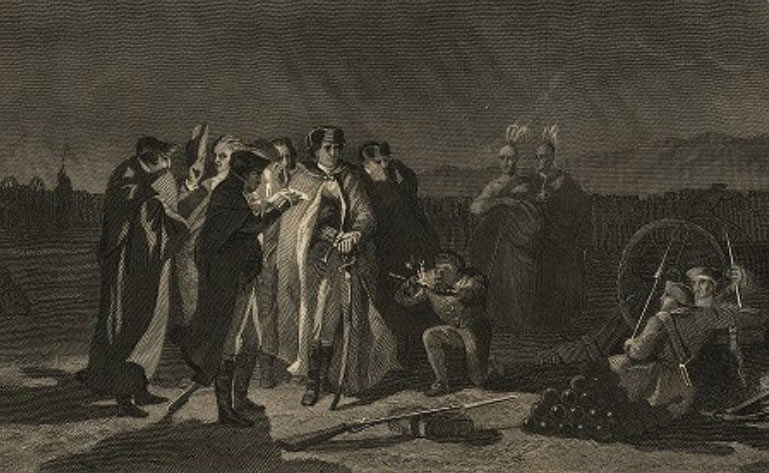
The night conference at Fort Necessity on 3rd July 1754
Dinwiddie’s attempt to evict the French from the Ohio Forks had failed due to a woeful lack of resources in men and equipment.
News of Fort Necessity reaches London:
Fort Necessity had an electrifying effect throughout the colonies and in Britain, where news of the incident was received in August 1754.
Suddenly, for a government and society until now obsessed with European affairs, the crisis in America took centre stage.
Washington’s letters to Dinwiddie were passed around government in London and made available to the press, where they were published. The King made a caustic comment on Washington’s naive description of his excitement at first hearing the sound of bullets in action during the Jumonville incident.
The slide to war was under way.
The previous section on Braddock’s defeat on the Monongahela in 1755 is Part 1: The origins of General Braddock’s expedition
The next section on Braddock’s defeat on the Monongahela in 1755 is Part 3: The Planning of General Braddock’s expedition
To the French and Indian War index
